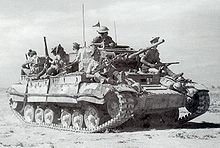
The Second Battle of El Alamein was a battle of the Second World War that took place near the Egyptian railway halt of El Alamein. The First Battle of El Alamein and the Battle of Alam el Halfa had prevented the Axis from advancing further into Egypt.

XXX Corps was a corps of the British Army during the Second World War. The corps was formed in the Western Desert in September 1941. It provided extensive service in the North African Campaign and many of its units were in action at the Second Battle of El Alamein in late 1942. It then took part in the Tunisia Campaign and formed the left flank during the Allied invasion of Sicily in 1943.
This is the complete order of battle of Allied and German forces involved during Operation Market Garden.

The 9th Armoured Division was an armoured division of the British Army, raised during the Second World War. It never saw active service during the war as a complete division.

The 22nd Armoured Brigade was an armoured brigade of the British Army that saw service during and after the Second World War. The brigade was formed on the outbreak of war on 3 September 1939 from Territorial Army (TA) armoured regiments. It saw a considerable amount of action during the war, beginning with the Western Desert Campaign where it was engaged in Operation Crusader and at the Battles of Gazala, Mersa Matruh, First Alamein and Alam el Halfa. It then joined the 7th Armoured Division for the Second Battle of El Alamein. It remained part of 7th Armoured for the rest of the war, including the campaigns in Tunisia, Italy and North West Europe. It continued in the postwar TA until 1956. The brigade was re-established, made up of regular regiments in Germany, between 1981 and 1993.

The 27th Armoured Brigade was an armoured brigade of the British Army that served in the Second World War and played a crucial role in the Normandy landings on 6 June 1944 and the following Battle of Normandy until disbandment in late 1944.

The 8th Armoured Brigade was an armoured brigade of the British Army formed in August 1941, during the Second World War and active until 1956. The brigade was formed by the renaming of 6th Cavalry Brigade, when the 1st Cavalry Division based in Palestine converted from a motorised formation to an armoured unit, becoming 10th Armoured Division.

The 10th Armoured Division was an armoured formation of division-size of the British Army, raised during the Second World War and was active from 1941–1944 and after the war from 1956–1957. It was formed from the 1st Cavalry Division, a 1st Line Yeomanry unit of the Territorial Army (TA) which had previously been serving in Palestine. The division was converted from cavalry to armour and redesignated from 1 August 1941.

The Royal Wiltshire Yeomanry (RWY) was a Yeomanry regiment of the Kingdom of Great Britain and the United Kingdom established in 1794. It was disbanded as an independent Territorial Army unit in 1967, a time when the strength of the Territorial Army was greatly reduced. The regiment lives on in B Squadron of the Royal Wessex Yeomanry.
Operation Battleaxe was a British Army offensive during the Second World War to raise the Siege of Tobruk and re-capture eastern Cyrenaica from German and Italian forces. The offensive's failure led to the replacement of British General Sir Archibald Wavell, Commander-in-Chief Middle East, by Claude Auchinleck; Wavell took Auchinleck's position as Commander-in-Chief, India.

The Second Battle of El Alamein was a battle of the Second World War that took place near the Egyptian railway halt of El Alamein. The First Battle of El Alamein and the Battle of Alam el Halfa had prevented the Axis from advancing further into Egypt.
This is the order of battle for Operation Brevity, a World War II battle between the British Commonwealth and the European Axis Powers of Germany and Italy in North Africa between May 15–16, 1941.
This is the order of battle for the Battle of Villers-Bocage, a World War II battle on 13 June 1944 between British and German forces in Normandy, France as part of Operation Perch.
This is the order of battle for the ground forces involved in Operation Crusader, a World War II battle between the British Commonwealth and the European Axis Powers of Germany and Italy in North Africa between 18 November – 30 December 1941.
The Battle of Monte Cassino order of battle for January 1944, is a listing of the significant formations involved in the fighting on the Winter Line in January 1944, during the period generally known as the First Battle of Monte Cassino.
Second Battle of Monte Cassino order of battle February 1944 is a listing of the significant formations involved in the fighting on the Winter Line in February 1944 during the period generally known as the Second Battle of Monte Cassino.
The Structure of the Egyptian Expeditionary Force over the course of the First World War is shown below.










